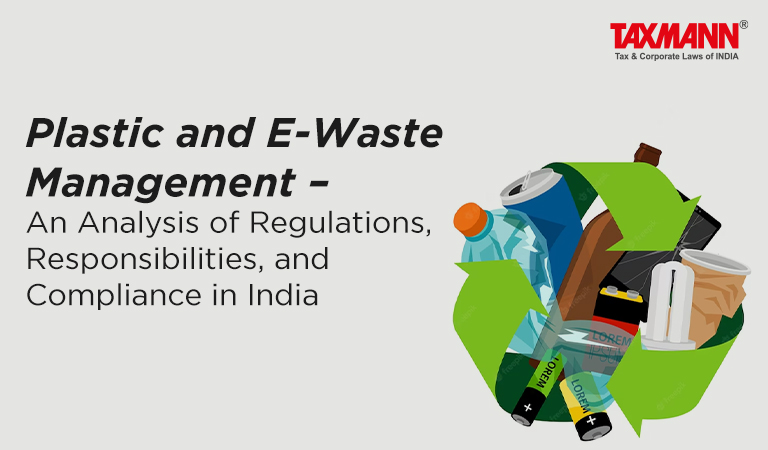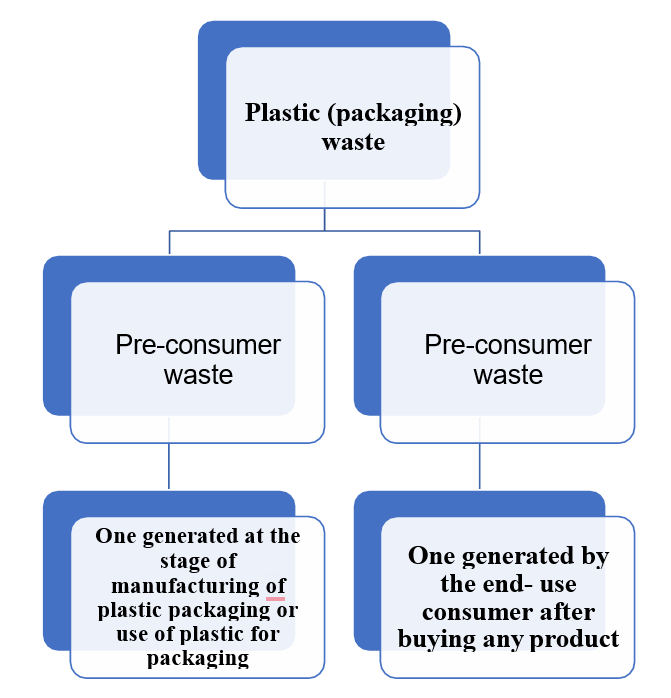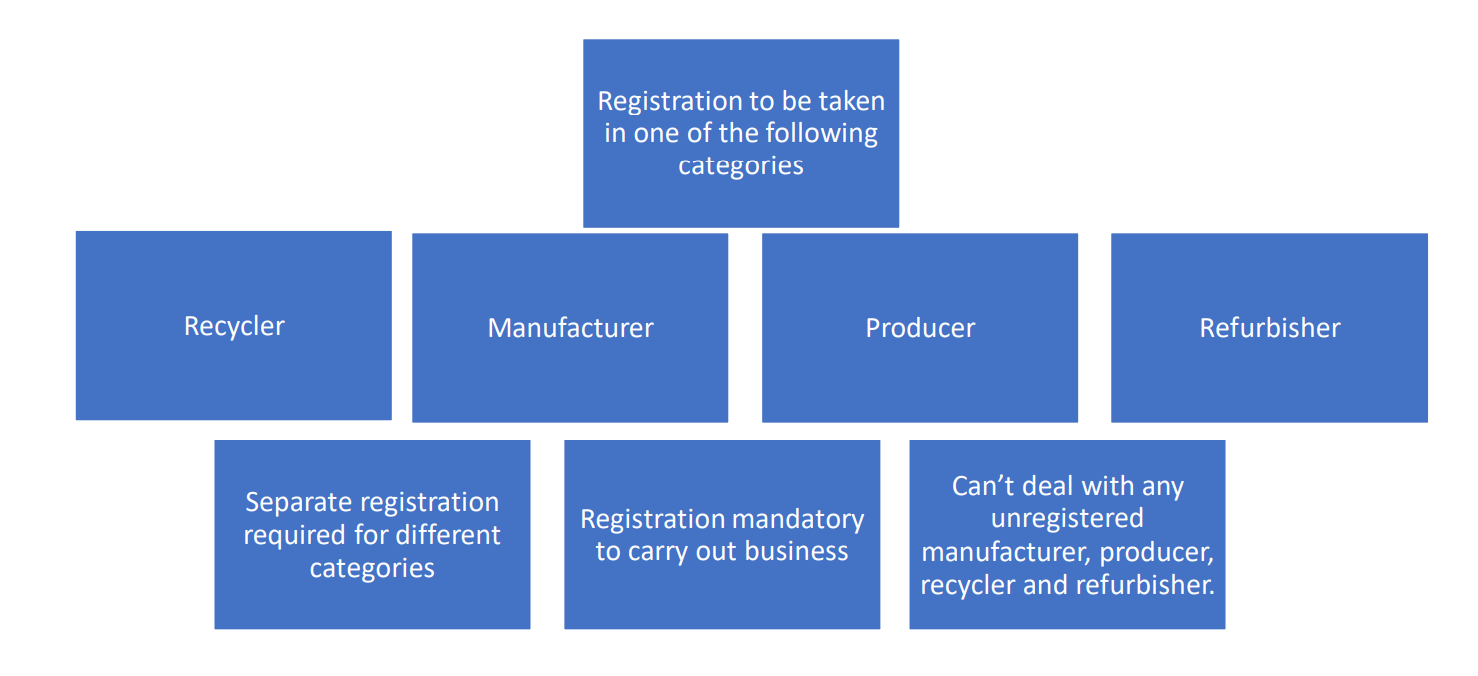Plastic and E-Waste Management – An Analysis of Regulations, Responsibilities, and Compliance in India
- Other Laws|Blog|
- 8 Min Read
- By Taxmann
- |
- Last Updated on 29 July, 2023

Table of Contents
1. The Plastic Waste
“Companies, not individuals, are the biggest plastic offenders” – Bloomberg
Specifically, 20 companies, which produce more than half of all single-use plastics – Minderoo Foundation
Each year, about 11 million metric tons of plastic waste ends up in bodies of water – United nations
“India produces 3.4 million tonnes of plastic waste in a year, only 30 per cent of it is recycled” – Indian Institute of Science (IISc) and Praxis Global Alliance
Why is it happening?
- Convenience > Sustainability
- Use & Throw Culture
- Out of Sight,Out of Mind

What does the rule say?
The Plastic Waste Management Rules, 2016 (PWM) mandate the generators of plastic waste to take steps to minimize generation of plastic waste, not to litter the plastic waste, ensure segregated storage of waste at source & hand over segregated waste in accordance with rules.
Responsibilities
PWM mandates the responsibilities of Local bodies, gram panchayats, waste generators, retailers and street vendors to manage plastic waste.
PWM cast Extended Producer Responsibility (EPR) on Producer, Importer, and Brand Owner
1.1 PWM – Features
- MoEFCC notified the PWM and the Solid Waste Management Rules, 2016 on April, 2016. As plastic waste is part of solid waste, therefore, both the rules apply to managing plastic waste in the country
- PWM mandates the generators of plastic waste to minimize generation of plastic waste, not to litter the plastic waste, ensure segregated storage of waste and hand over waste in accordance with rules
- PWM cast EPR on Producer, Importer, and Brand Owner. EPR applicable to both pre-consumer and post-consumer plastic packaging waste
- Not applicable on EOU and SEZ mfg goods for exports (except those dealing in gutkha, pan masala)
- SCH II Not applicable on Small and Medium Brand Owners as per MSME guidelines; no exception for producers and importers
- Trading of certificates provided
1.2 Category of Plastic Packaging

- Category I – Rigid plastic packaging;
- Category II – Flexible plastic packaging of single layer or multilayer (more than one layer with different types of plastic), plastic sheets or like and covers made of plastic sheet, carry bags, plastic sachet or pouches;
- Category III – Multilayered plastic packaging (at least one layer of plastic and at least one layer of material other than plastic);
- Category IV – Plastic sheet or like used for packaging as well as carry bags made of compostable plastics.
1.3 EPR Coverage and Applicability
Producer
A person engaged in manufacture or import of carry bags or multi- layered packaging or plastic sheets or like, and includes industries or individuals using plastic sheets or like or covers made of plastic sheets or multi- layered packaging for packaging or wrapping the commodity;
Importer
A person who imports plastic packaging or products with plastic packaging or carry bags or multilayered packaging or plastic sheets or like
Brand Owner
Brand Owners including online platforms/ marketplaces and supermarkets /retail chains other than those, which are micro and small enterprises as per the criteria of Ministry of Micro, Small and Medium Enterprises, Government of India. a person or company who sells any commodity under a registered brand label or Trademark
PWP
Recyclers of plastic waste as well as entities engaged in using plastic waste for energy (waste to energy) including in coprocessing or converting plastic waste to oil (waste to oil) except in cases where feedstock chemicals are produced for further use in the production of plastic which may then be considered under recycling , industrial composting
1.4 4 Pillars of Obligations
- Reuse
- Recycling
- Use of recycled plastic content
- End of life disposal
1.5 EPR Target – PIBOs & Formulas for calculating EPR liability
| Category | Year | EPR target (as a percentage of Q1 – category-wise) | EPR target (as a percentage of Q1 – category-wise) | EPR target (as a percentage of Q1 – category-wise) |
| Producer | Importer | Brand Owner | ||
| I | 2021-22 | 25% | 25% | 25% |
| II | 2022-23 | 70% | 70% | 70% |
| III | 2023-24 | 100% | 100% | 100% |
| Q = (A+B)-C | Q = (A+B)-C | Q =D+B |
- Q: Eligible Quantity in MT
- A: The average weight of plastic packaging material sold in the last two FYs
- B: The average quantity of pre consumer plastic waste generated in last two FYs
- C: Quantity of plastic sold to Brand Owners in last financial year
- D: The average weight of plastic waste purchased/introduced in the last two FYs
1.6 PIBOs – Obligation for Recycling
PIBOs shall ensure minimum level of recycling (excluding end of life disposal) of plastic packaging waste (% of EPR Target)
| Plastic packaging category | 2024-25 | 2025–26 | 2026-27 | 2027-28 and onwards |
| Category I | 50 | 60 | 70 | 80 |
| Category II | 30 | 40 | 50 | 60 |
| Category III | 30 | 40 | 50 | 60 |
| Category IV | 50 | 60 | 70 | 80 |
PIBOs – Obligation for use of recycled plastic content
Mandatory use of recycled plastic (% of plastic purchased)
| Plastic packaging category | 2025-26 | 2026-27 | 2027-28 | 2028-29 and onwards |
| Category I | 30 | 40 | 50 | 60 |
| Category II | 10 | 10 | 20 | 20 |
| Category III | 5 | 5 | 10 | 10 |
1.7 End of Life Disposal
- Only those plastics, which cannot be recycled will be sent for end of life disposal such as road construction, waste to energy, waste to oil, cement kilns (for co processing) etc. as per relevant guidelines issued by Indian Road Congress or CPCB from time to time.
- The PIBOs shall ensure end of life disposal of the plastic packaging waste only through methodologies as specified in PWM
1.8 Role of PIBOs
- Not Allowed to Conduct Business Without Obtaining EPR Registration.
- Register on Portal Developed by CPCB.
- Fulfill EPR Target Obligations From the Next Year.
- Operating in One or Two State; Register With SPCB or Pollution Control Committee.
- Separate Registration Required for Different Sub-Category Like Importer and Brand Owner
- Furnish Details of EPR Target to CPCB
1.9 Application process and timelines
- Application with required enclosures
- CPCB to review and respond within 25 days.
- Submission of additional information, if required by CPCB.
- Grant of Certificate by CPCB within 120 days.
| Quantity of Plastic (In Tonnes) | Application fees |
| Q > 1000 | Rs. 10,000/- |
| 1000 – 10,000 | Rs. 20,000/- |
| 10,000< Q | Rs. 50,000/- |
- First registration certificate valid for 1 year and subsequent for 3 years; apply for renewal 180 days in advance
- Separate registration for each category of P, I and BO. Operations in 2 states register with SPCB else CPCB
- Service providers (IT/ITeS companies, R&D units etc.) importing goods in plastic packaging covered
- Customs allowing clearances on the basis of application till 31 August 2023
- Annual return for FY 23 by 31st Oct 2023 and for subsequent years by 30th June after end of FY
1.10 Generation of surplus EPR certificates – Carry forward, offsetting & Sell
- PIBOS Who Have Fulfilled Their EPR Targets, Can Use the Surplus for off Setting, Carry Forward or Sell It to Other PIBOS
- Surplus in One Category Can Only Be Used for Off-Setting, Carry Forward and Sale in the Same Category.
- PIBOS Can Meet Their EPR Targets by Purchasing Surplus EPR Certificates of the Same Category.
- Details of Such Transactions to Be Submitted While Filing Annual Returns of EPR.
Plastic Waste Processors can also sell certificates to PIBOs
1.11 Penalty for Non-Compliances
- CPCB/SPCB to Impose Environmental Compensation (EC) For Non- Fulfilment of EPR Targets.
- Payment of EC Not to Absolve the Obligation.
- Three Year Window to Fulfill the Shortfall.
- If Not Done in Three Years, Entire Amount Be Forfeited.
2. The “e-Waste”
The ratio of generating e-waste in India is 75% of electronic waste from government, public and private sector companies, and 16% from individual households. – Indian Express
China, the US, and India produce the most e-waste. – Theroundup.org
“e-junk witnessing 31% annual growth in India”. – Deccan Herlad
India recycled only 32.9 per cent of the e-waste generated in 2021-2022. – Data from MOEFCC
2.1 E-waste Rules 2022 – Application
Applicable on every manufacturer, producer refurbisher, dismantler and recycler involved in manufacture, sale, transfer, purchase, refurbishing, dismantling, recycling and processing of e-waste or electrical and electronic equipment listed in Schedule I (including their components, consumables, parts and spares which make the product operational) except the following

2.2 Entities Covered
- Manufacturer – person or an entity or a company which has facilities for manufacture of electrical and electronic equipment (EEE) as specified in Schedule-I
- Producer – any person or entity who, –
- manufactures and offers to sell EEE and their components/consumables/parts/spares; or
- offers to sell under its own brand, EEE and their components or consumables or parts
- offers to sell imported EEE and their components/consumables/parts/spares; or
- who imports used electrical and electronic equipment
- Refurbisher – any person or entity repairing or assembling used EEE as listed in Schedule-I for extending its working life over.
- Recycler – any person or entity who is engaged in recycling and reprocessing of waste EEE or assemblies or their components or their parts
Bulk consumers – Entities which use at least 1000 units of electrical and electronic equipment at any time in an FY
Bulk consumers to hand over E-Waste only to the registered producers, refurbisher or recycler
2.3 EPR Framework

2.4 Responsibilities
| Manufacturer | Producer | Refurbisher | |
| Register on the portal | Y | Y | Y |
| Collect e-waste generated during the manufacture and recycle | Y | Y | |
| File Annual and Quarterly return | Y | Y | Y |
| Obtaining and implement EPR targets. | Y | ||
| Creating awareness through media, publications, etc | Y |
E-waste can be stored for a period 6 months only. Records to be maintained for sale, transfer or storage
2.5 Solar photo-voltaic modules or panels or cells
- Separate chapter for solar photo-voltaic modules or panels or cells
- Every manufacturer and producer of solar photo-voltaic modules or panels or cells to obtain registration
- Store solar photo-voltaic modules or panels or cells waste generated up to the year 2034- 2035 as per the guidelines
- File annual returns on or before the end of the year to which the return relates up to year 2034-2035
- Comply with SOP and guidelines laid down by the CPCB
2.6 EPR Modalities
- Producers to Fulfil EPR Obligation.
- Can Take Help of Pro, Collection Centres, Dealers Etc.
- EPR Shall Lie Entirely on the Producer Only.
- EPR to Be Decided Basis Information Provided by the Producers
- Online Purchase of EPR Certificate From Registered Recyclers Only
- Certificate Valid for 2 Years
2.7 EPR Certificate Generation
- The CPCB to generate EPR certificate in favour of a registered recycler
- The quantity eligible for generation of EPR certificate shall be calculated by :
*QEPR = Qp x Cf
QEPR is the quantity eligible for generation of the certificate, Qp is the quantity of the end product and
Cf is the conversion factor (quantity of inputs required for production of one unit of output)
- EPR certificate valid for 2 years from the end of the FY in which it was generated
- Each EPR certificate to have a unique number
- EPR certificates to be in the denominations of 100, 200, 500 and 1000 kg
- Proportionately purchase EPR certificate quarterly basis and submit it with quarterly return
- As soon as the producer purchases EPR certificates, it shall be automatically adjusted against its liability
- All the transactions to be recorded and submitted by the producers or recyclers on portal
2.8 E-waste Recycling Targets
Schedule III
| Sl. No. | Year (Y) | E-Waste Recycling Target (by weight) |
| 1 | 2023 -2024 | 60% of the quantity of an EEE placed in the Market in the Year Y-X |
| 2 | 2024 -2025 | 60% of the quantity of an EEE placed in the Market in the Year Y-X |
| 3 | 2025 -2026 | 70% of the quantity of an EEE placed in the Market in the Year Y-X |
| 4 | 2026-2027 | 70% of the quantity of an EEE placed in the Market in the Year Y-X |
| 5 | 2027-2028 | 80% of the quantity of an EEE placed in the Market in the Year Y-X |
| 6 | 2028-2029 onwards | 80% of the quantity of an EEE placed in the Market in the Year Y-X |
*X represents average life of that product
Schedule IV
| Sl. No. | Year (Y) | E-Waste Recycling Target (by weight) |
| 1 | 2023 -2024 | 15% of the sales figure of financial year 2021-22 |
| 2 | 2024 -2025 | 20% of the sales figure of financial year 2022-23 |
| 3 | 2025 -2026 | 20% of the sales figure of the financial year two years back |
EPR targets for producers, who have started sales operations recently, i.e. number of years of sales operations is less than average life of their products mentioned in the guidelines issued by the CPCB. Once the number of years of sales operation equals the average life of their product, their EPR obligation shall be as per Schedule- III
2.9 Penalty for Non-Compliances
- CPCB/SPCB to Impose Environmental Compensation (EC) For Non- Fulfilment of EPR Targets.
- Payment of EC Not to Absolve the Obligation.
- Three Year Window to Fulfill the Shortfall.
- If Not Done in Three Years, Entire Amount Be Forfeited.
Disclaimer: The content/information published on the website is only for general information of the user and shall not be construed as legal advice. While the Taxmann has exercised reasonable efforts to ensure the veracity of information/content published, Taxmann shall be under no liability in any manner whatsoever for incorrect information, if any.

Taxmann Publications has a dedicated in-house Research & Editorial Team. This team consists of a team of Chartered Accountants, Company Secretaries, and Lawyers. This team works under the guidance and supervision of editor-in-chief Mr Rakesh Bhargava.
The Research and Editorial Team is responsible for developing reliable and accurate content for the readers. The team follows the six-sigma approach to achieve the benchmark of zero error in its publications and research platforms. The team ensures that the following publication guidelines are thoroughly followed while developing the content:
- The statutory material is obtained only from the authorized and reliable sources
- All the latest developments in the judicial and legislative fields are covered
- Prepare the analytical write-ups on current, controversial, and important issues to help the readers to understand the concept and its implications
- Every content published by Taxmann is complete, accurate and lucid
- All evidence-based statements are supported with proper reference to Section, Circular No., Notification No. or citations
- The golden rules of grammar, style and consistency are thoroughly followed
- Font and size that’s easy to read and remain consistent across all imprint and digital publications are applied






Please clarify (a) Liability of FY24 (Apr23 – Mar24) for Brand Owner shall be based on average purchases in preceding 2 years viz. FY22 and FY23 and not dependent on purchases made in FY24 (b) timelines by when the said liability has to be discharged